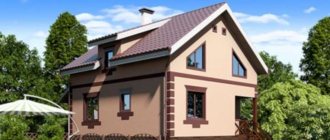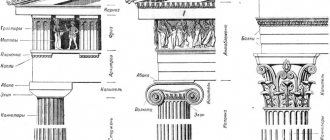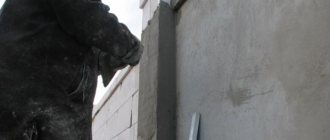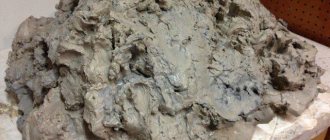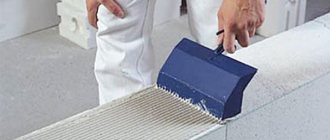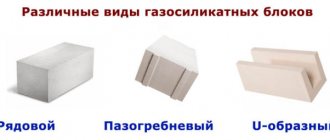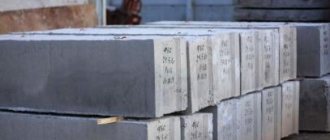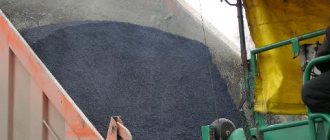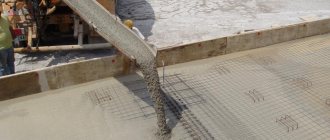The construction of a bathhouse or garage is not a large-scale construction project and, accordingly, does not require high-strength, reliable materials. As a rule, for these purposes, buyers try to purchase cheaper types of products. And it’s even better if you can make them yourself: the raw materials are available, the technology is simple. One of them is cinder block, which is often reviewed in discussions on forums. The problem is that the opinions are not just different - they are diametrically opposed. Let's try to figure out what's what.
What is cinder concrete?
According to the dictionary, cinder block is a building stone that is made by vibration pressing from a special solution. Includes:
- The main filler is slag - blast furnace melt, a crust of impurities that forms after smelting the base metal. The same term refers to solid waste generated as a result of certain chemical processes and sintered ash from the combustion of coal, peat, oil shale and other types of fuel.
- Cement is a binder that has a fastening effect.
- Water.
The production of cinder blocks at home does not require a special vibrating machine. Natural shrinkage processes, although longer, allow us to obtain acceptable quality of the finished product. In this case, substitutes are often used instead of slag: granite or river crushed stone, screenings, broken brick or concrete, and much more.
What to consider when building a house
The best option would be to order a house project from a professional construction company. They will make a drawing that shows the entire layout of the structure, including the location of windows and doors. The project also takes into account all the nuances that can affect the finished building.
After this, you can hire workers for construction or do it yourself. If the second option is chosen and the decision is made to build a house from cinder block, then first of all it is worth deciding on the composition of this material. The durability of the constructed home depends on the correct choice. This building material, like any other, has its pros and cons.
Photo: cinder block house
Foreman's advice : when choosing, you must give preference to cinder block, the filler of which is expanded clay, shell rock or crushed stone.
It is also recommended to pay attention to the following parameters:
- Correct block geometry. The quality of the masonry depends on it. You can check using a regular measurement.
- Strength of the material. You can try driving a 15mm nail into the block. If it works, then the material is of poor quality and is not worth purchasing.
- Clarify the method of making blocks. If they are made in a vibration-free manner, then they are not suitable for building a house.
- It is necessary to pay attention to such characteristics of the building material as thermal conductivity and frost resistance.
Once the choice of materials has been made, you can begin building the house. But even during this action there are some nuances:
- It is necessary to choose the right wall thickness based on climatic conditions.
- Before plastering the wall, it is necessary to prepare it to avoid subsequent peeling.
- It is strictly not recommended to use cinder block in the foundation due to its high hygroscopicity (propensity to absorb moisture).
Is cinder block harmful or not?
The Internet is teeming with messages about the construction of housing from cinder blocks. This is a fairly inexpensive method, plus various equipment allows you to make cinder blocks at home. We will try to determine whether it is actually so profitable and safe.
Advantages of the cinder block system . The ability to independently produce blocks using vibrating tables or presses, which are available in a wide range on the market. You can also choose the standard size of cinder blocks yourself. The most common: 200x200x400 mm, 390x190x188 mm, 150x150x310 mm. Accordingly, the wall thickness can be 400, 390, 360 or 130 mm. The next advantage is the price of cinder blocks, which is significantly lower than that of the same brick, and in terms of strength they are almost the same.
A cinder block house can be built many times faster, spending the least amount of effort, using the most common material in your region. Well, a square meter of block masonry is one and a half times lighter than the same brick masonry - this reduces the load on the foundation by almost 2 times. Plus, the solution is saved due to the larger block area. The cost of construction is generally reduced by 40%. Add to this the different colors of stones and the opportunity to independently choose the color of your future home. The disadvantages of such construction include, first of all, the possible non-environmental friendliness of the structure. It is no secret that for the production of cinder blocks , coal combustion waste, ash, and slag are used, although, if desired, you can add sawdust, crushed stone, broken brick, expanded clay, etc. Cinder blocks made in one region differ from blocks made in another precisely in quality and type of filler. The cinder block itself is safe, but it is very “afraid” of water. Open water quickly begins to erode the base, and then the toxic filler can pose a danger. Careful and mandatory plastering of the surface or covering it is necessary. The hygroscopicity of cinder concrete also leads to increased humidity and mold formation.
The disadvantages also include poor noise insulation and strong thermal conductivity.
And so we looked at the main pros and cons of the cinder block system. On the one hand - savings and accessibility, on the other - environmental friendliness and durability. But still, before starting construction, it would not be a bad idea to break off a piece of your future home and check its toxicity in order to be sure of the safety of your family and friends.
Reviews from owners of cinder block houses
Vasily Kononenko, Volgograd He built a house from cinder blocks and did not insulate it with anything. The heat loss is simply amazing; it is necessary to spend a lot of fuel to heat the rooms. Next summer I'll do some insulation.
Alexander Faragovsky, Tyumen He built himself an excellent house, fortunately he immediately insulated it and therefore felt quite comfortable in the winter. I want to share a method for choosing a cinder block. You need to lift it about a meter and throw it. If it doesn't break, then you can take it. I chose this way myself.
Igor Storozhev, Kaliningrad I am quite pleased with my house, built from Soviet cinder block. Of course, if you build a home from this material, then you definitely need to take care of its insulation and protection from moisture - if the cinder block absorbs moisture, it will begin to collapse, which is completely unacceptable.
Cinder block: pros and cons
Another artificial stone for construction. Let's consider its qualities, pros and cons. First, let's look at what a cinder block is. Building stone of artificial origin, obtained by vibrocompressing concrete into the desired shape. It consists of water, cement, ash, slag, coal combustion waste and similar fillers. It is very simple to manufacture and very cheap. But the first drawback is that a fresh cinder block must be left to rest (settle) in the open air for at least one year, since in its freshly prepared form it is harmful to humans. The thickness of the walls in a residential building built from cinder blocks and used as permanent housing must be at least 90 centimeters. This is still without a layer of plaster.
Cinder block is very frost-resistant and very durable, which explains its fragility and rapid wear. But with all this, it is very resistant to atmospheric conditions and is not afraid of water even with constant contact. One of its disadvantages is its high thermal conductivity, from which it follows that a house built from it will heat up very quickly and also quickly lose all the heat, that is, it will simply be cold. As they say, you won't get drunk. Also, cinder block is divided into two, let’s say, subspecies, heavy and light. The first is almost always used for laying the base, in the construction of the foundation, that is, monolithic masonry, when the strength and weight of the foundation is required, since it is very heavy and inconvenient for laying walls. In addition to water and cement, the heavy form filler includes crushed stone, pebbles, and coarse sand. The light one is filled with expanded perlite, expanded clay, wood ash, sawdust or pine needles. All this makes it very light compared to its heavy brother and more environmentally friendly. It is preferable for residential premises, despite its obvious disadvantage - exposure to moisture, the solution is to be faced with brick or wood, or protective facade plaster.
The production technology consists of several stages, which are very simple in nature. With the appropriate skills, you can prepare it at home. And almost any private developer can carry out masonry work, the main thing is that the hands grow where they need to. Of course, in the modern world, construction from cinder blocks looks like an anachronism, because there are more convenient and high-quality materials. But it remains cheap and easy to install. Well, you won’t use expensive materials in the construction of sheds and garages, and a cinder block is ideal for this.
What is a cinder block, and what do cinder block houses look like in the photo
A cinder block is a kind of block made from a mixture and additives. It is known that the raw material for this building material is crushed stone, crushed and heated in a special way. Broken glass or expanded clay, shavings and sawdust, ash, ash, as well as ordinary river sand are also used to create bricks.
Such a characteristic as the strength of a cinder block depends on its brand. The range of values varies from 35 to 125 kg/cm².
The lower value of the indicator means that this type of cinder block can be used as an additional structure when strengthening non-load-bearing and low structures. For example, fence, or highlight. Brand 50-75 kg/cm² is suitable for internal partitions, 100-125 kg/cm² is material for load-bearing walls. The strongest solid bricks can be used in the construction of structures that are partially submerged in water.
Important!
Granite can produce an unpleasant radioactive background. It is better not to buy blocks with such fillers. To control the quality of the product, you can rent a Geiger counter while purchasing the material.
Choose an even block or section of blocks, paying attention to the geometric shape. Chips in a batch may indicate a technological defect and a violation of production technology.
A comment
Head of the repair and construction team
Ask a Question
“It’s better not to use soft blocks. If you're planning on purchasing a cinder block, don't hesitate to bring a nail. If you managed to stick it into the material without using a hammer, then it is better not to consider such a cinder block for purchase.”
Use pallets to transport blocks
Characteristics and sizes of different types of cinder blocks
Different types of blocks are used for different tasks. A separate type of building structures is used for insulation, another for the construction of strong walls, and a third for decoration.
Durable solid cinder blocks
For the construction of load-bearing walls and ceilings, use only solid blocks. They must be selected according to their strength class. Foundation blocks made of slag concrete are especially in demand. But you need to remember that they can shrink and need a reliable one.
Lightweight hollow cinder blocks
Hollow cinder blocks are often used to build lightweight interiors. Voids can be oval, round, square or rectangular. The size of such voids is approximately a third of the volume of the building element.
Typically, blocks of the following sizes are used: 39 × 19 × 18.8 cm. If compared with bricks, then 12 bricks “fit” in the volume of one cinder block.
Decorative cinder blocks
Decorative material is rarely used for the construction of large structures. Typically, colored bricks are used in the construction of fencing, as well as supports.
Important!
Do not forget that the foundation must be settled before building the walls. At least a month. Only after this can the next stage of work begin.
How to properly lay a cinder block on a foundation: video instructions
Laying begins from the corners. In each of them special fasteners are attached, which are leveled. Then a cord or rope is pulled through.
For an example of laying a cinder block wall, see the video below:
How to build the walls of a house yourself - features of laying cinder blocks
It is better to build a house made of cinder blocks in the warm season. According to the technology, use at temperatures below +15°C is not allowed. It is recommended to leave a seam no larger than one or one and a half centimeters. The elements are laid offset by half a stone.
Again we check ourselves with the level
Reinforcement needs to be done in every fourth row. To do this, recesses are made using an electric milling machine and pieces are inserted. This technique allows you to make the walls much stronger.
Roofing and interior finishing
Cinder block house is harmful to health
Not environmentally friendly at all, from the production of raw materials to the finished product and its operation.
silicate brick is essentially pressed and sintered sand. One of the disadvantages is that there may be an increased background radiation (especially for Dnipropetrovsk), but increased does not mean dangerous. It still has its effect, the material is not human. cinder block is an excellent building material, an example of recycling industrial waste. We recommend reading: Disclose the incentive measures applied to convicts
Domain
The material is obtained by smelting cast iron. The composition includes the remains of rock, fluxes and fuel ash. The pieces are very porous, the material is free-flowing.
In private construction, the fine (heavier) fraction is used to fill cavities in walls or to screed concrete floors. The large fraction is light in weight and is suitable for backfilling attic floors.
This type of raw material is used for the production of slag heat-insulating materials.
The most suitable for insulation is slag pumice, which has good heat and sound insulating properties. It also goes into filler for cinder blocks.
We invite you to familiarize yourself with the Admiral Salad. Cooking recipes
Conclusion
We cannot say unequivocally that it is better not to build residential buildings from cinder blocks. Those people who live in such a house and do not know the problems will not understand us. We will not promote this material either. One thing is certain, this material belongs to the future. And it’s up to you to decide what to build from.
Cinder block has been used in construction since the last century. It gets its name from the fact that it consists of the slag remaining after burning coal. Recently, the composition of the material has changed: expanded clay, brick chips, and granite began to be added to it. The only thing that has not changed is the main binder composition – M-500 cement.
It is easier and faster to build a house out of it than, for example, out of brick. The material is much larger in size and it is much easier to install.
